Thursday, 9:00am
16 October 2014
Energy and emotion
Larry Fink
Alex Webb
Rebecca Norris Webb
André Kertész
Henri Cartier-Bresson
Josef Koudelka
Walker Evans
Ralph Eugene Meatyard
Lee Friedlander
Book design
Photography
Visual culture
Critique / Photography
Aperture’s new series of photography books may prove to be an essential educational resource for serious smartphone snappers

Photo Critique by Rick Poynor, written exclusively for eyemagazine.com.
This should be a good time to publish books designed to help people take better photographs. For many, mobile snapping has become a routine, daily pursuit. A publishing initiative from Aperture Foundation, titled the Photography Workshop Series, aims to introduce this new audience to the creative thinking of established photographers. ‘Instagram is full of potential recruits,’ Aperture’s executive director Chris Boot told Publishers Weekly. ‘These books are for them.’
Two titles have appeared to date, Larry Fink on Composition and Improvisation and Alex Webb and Rebecca Norris Webb on Street Photography and the Poetic Image. A third, Todd Hido on Landscapes, Interiors, and Some Nudes, is due soon. These are not technical manuals and they don’t include any practical advice about camera use, lighting or image manipulation. Instead, they match pictures with short texts to highlight key aspects of the photographers’ working processes. The theme is usually signalled with a title in bold, such as ‘Breaking the Frame’, ‘The Unexpected Metaphor’ or ‘Perception and Perspective’. Every spread has at least one picture, though there is never more than one per page, and there are generous amounts of white space. As a reading experience, the books feel more like monographs with expansive captions than generic how-to guides.
Spread showing Larry Fink’s Pat Sabatine’s Eighth Birthday Party, Martins Creek, Pennsylvania, April, 1977.
Top: Alex Webb, Bombardopolis, Haiti, 1986.
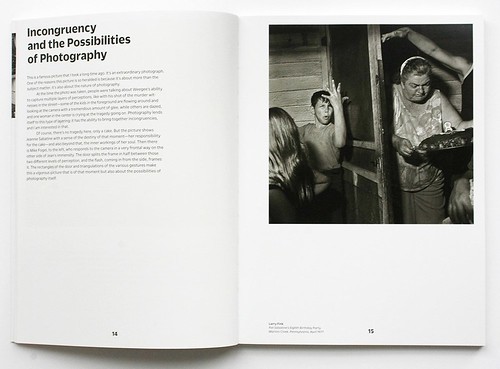
Spread showing Rebecca Norris Webb’s Homestead Blizzard, 2005-2011.
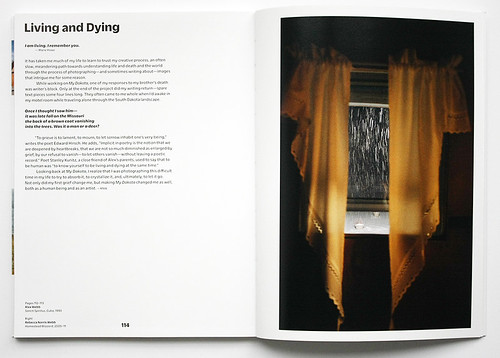
It’s clear from the first two that the series will allow the photographers some latitude within this format. Larry Fink shows only his own black-and-white pictures. The Webbs, who are married and work together sometimes, include pictures by André Kertész, Henri Cartier-Bresson, Walker Evans, Josef Koudelka, Ralph Eugene Meatyard, Lee Friedlander and others, alongside their own. Both books are based on what the authors impart in public workshops, so differences of style and emphasis are bound to follow from their ways of teaching. The chance to compare the two titles inevitably raises questions about what works best when a teacher’s personality and presence is distilled into writing on the page.
Cover of Alex Webb and Rebecca Norris Webb on Street Photography and the Poetic Image, Aperture. Book design: Studio Rubic.
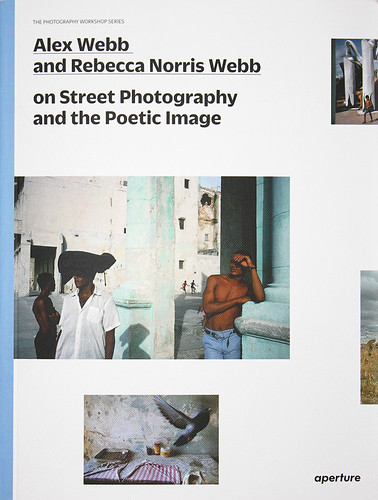
My reaction to immersion in the books turned out to be the opposite of what I expected. The Webbs’ pictures are closest to my interests and tastes. Alex Webb, whose work was collected in The Suffering of Light (2011), is a master of colour with an astonishing ability to get in among people on the street and capture small simultaneous events in complex compositions that cohere into mysterious completeness. In a picture taken in Bombay in 1981, a child emerges from the shadows under painted posters of two huge eyes; all the other figures are lost in shadow and only the child observes the photographer’s presence. Rebecca Norris Webb’s pictures are usually of objects and places rather than people and there is sometimes a layer of some kind between photographer and subject. Originally a poet, she tests the relationship between word and image in her published projects (although the Aperture book doesn’t show this), and her pictures of stained glass, an abandoned farmhouse or plastic bags caught on a barbed wire fence are closest to the kind I aspire to take myself. Early on, she quotes a poem by Emily Dickinson that encapsulates her method: ‘Tell all the Truth but tell it slant.’
Spread from Alex Webb and Rebecca Norris Webb on Street Photography and the Poetic Image showing Harry Gruyaert’s Train Paris-Brussels, 1979 (left) and Alex Webb’s Gouyave, Grenada, 1979 (right).
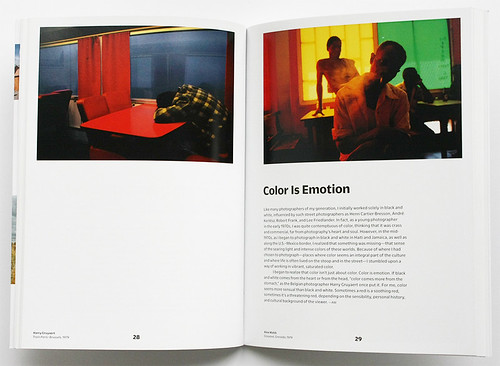
Spread showing Rebecca Norris Webb’s Stained Glass, 2005-2011.
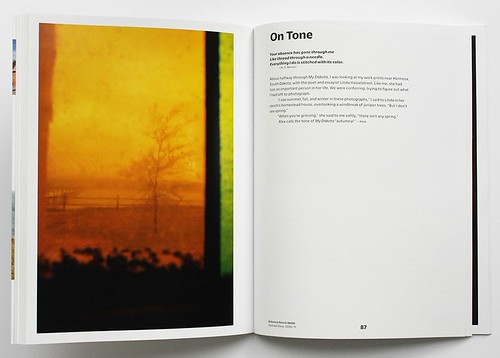
Some of her images deal with bereavement after losing her brother, and both bodies of work are magnificently eloquent in their emotion. But the Webbs, despite the literary references, are less illuminating than their pictures. When Alex Webb says, ‘I’m most drawn to poetic images that are suggestive, elusive, and, ultimately, mysterious’, or that he believes in pictures ‘that convey a certain level of ambiguity’, he is simply stating what the images already show. What we want to learn, as students, is how to instil our photographs with these qualities. The same is true when Rebecca Norris Webb observes that ‘creative tension may also be an integral part of a photograph’s structure’. She goes on to stress the importance of foreground and background, near and far, the ground and the horizon, but doesn’t analyse how these devices work in a particular picture, surely the most effective way of making the point. Where Alex Webb says too little about images that rank as some of the most sublime colour pictures of the past 40 years, his partner tends to deliver wodges of autobiographical detail in place of revelatory close reading.
Cover of Larry Fink on Composition and Improvisation, Aperture. Book design: Studio Rubic.
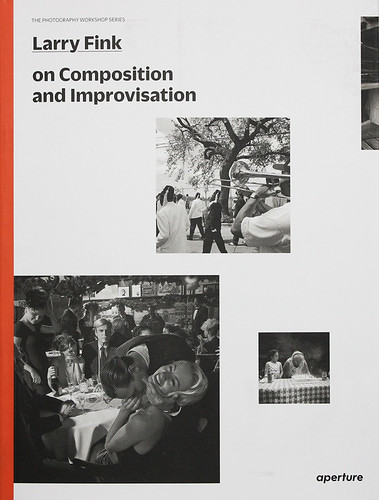
If his energy on the page is anything to go by, a workshop encounter with Larry Fink must be like grabbing a power cable firing out sparks. Fink wants to show readers how to produce pictures that are ‘visually arresting, emotionally charged, and deeply personal’ – qualities his own work displays in abundance – and he attacks the task with furious commitment. He is an excellent critic of his own images. He shows a picture and – bam! – without a wasted word, he lays bare its inner workings. Put your thumb over the table in the corner of this study of a boxer. See the way it flattens the image: there’s no tension without the table. Notice how the hand at the bottom in this shot pulls away from the geometry of the scattered papers, but ends up increasing the tension by drawing attention to the piano player’s concentration. Look here at the loops formed by the swirling dancer’s hand, the man’s bent knee, the woman’s elbow. This unstageable picture of a ‘great-looking gal’ at Studio 54 in New York, who turned out later to be a guy, ‘wasn’t made, it was taken,’ says Fink.
Larry Fink’s Dave Burrell on Archie Shepp’s piano, August 1966.
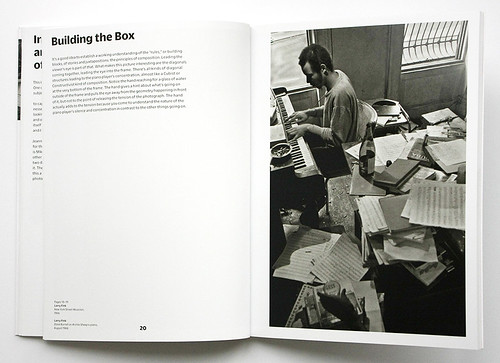
Photographs of nightclubs, Oscar parties and fashion weeks don’t hugely appeal to me, as a rule, but Fink’s commentary drew me into the social worlds he pictures with such desire, intimacy and soulfulness. He has pulled off the tricky feat of finding an explanatory vocabulary that is both adequate to the images and engagingly personal. He defines the primal nature of empathy, for instance, as ‘an animality informed by complex consciousness’. ‘A picture doesn’t have energy,’ he insists, ‘if it’s too symmetrical or overwrought by constipated intellectuality.’ He describes a shot of a ‘zoned-out boy’ in the hall at Cleveland School of Arts, where Fink had no way to be sure about the outcome, as ‘the score of a multileveled event with different kinds of intimacies and enigmas, with both forthcoming and receding energy’ – and that’s exactly what it amounts to.
Spread showing Fink’s photographs of Studio 54, 1977.
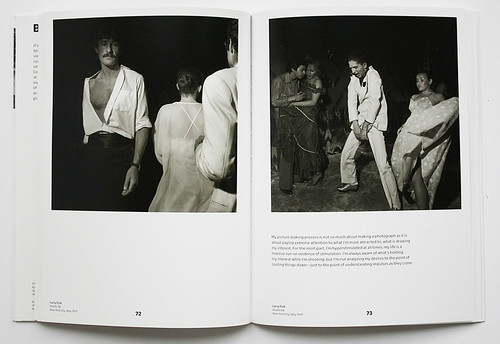
The Photography Workshop Series has the potential to become a highly accessible educational resource. The books are bound in hard-wearing textured covers and they feel good to handle. I hope the series will expand soon to include photographers from outside the US. Seasoned practitioners will find many ways to pass on their wisdom, but future books will be more instructive for readers the more precisely they pay attention to the photographs. They are for picture-takers with a developed interest in the medium rather than for casual snappers.
Larry Fink, Peter Beard and Friends, East Hampton, August 1976.
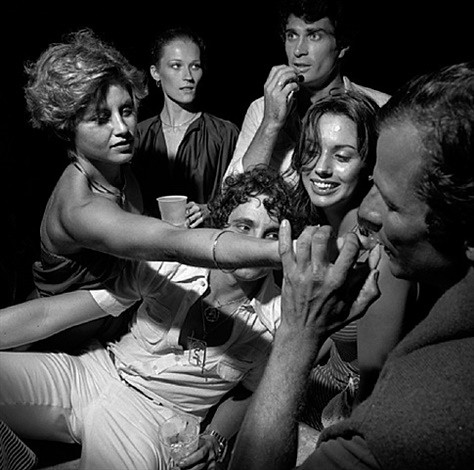
Rick Poynor, writer, Eye founder, London
Eye is the world’s most beautiful and collectable graphic design journal, published quarterly for professional designers, students and anyone interested in critical, informed writing about graphic design and visual culture. It is available from all good design bookshops and online at the Eye shop, where you can buy subscriptions and single issues.